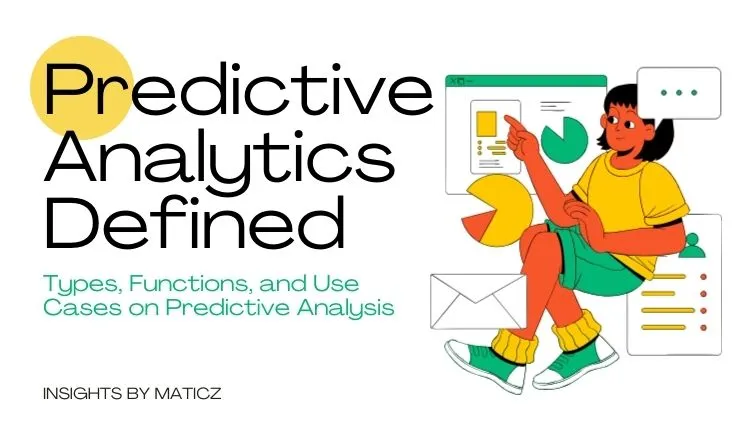Share Posts

What is Predictive Analytics?
46
3390
103
Introduction
According to recent trends, the attraction towards predictive analytics has been harmoniously increased over the last few years. As the business has started welcoming digital transformation and improved data-driven decisions, Predictive data analytics has taken its place. If You are looking to streamline the marketing campaign, improve customer experience, and reduce expenses, Predictive data analytics can be used.
Organizations are highly utilizing predictive analytics to identify patterns in data, both risks and opportunities. They are closely connected to big data and data science which forecasts future events. Extraction of invaluable insights from this information requires the application of deep learning and machine language to uncover the patterns. Let's have a clear understanding of how predictive data analytics raise the business towards a better tomorrow.
Predictive Analytics Defined
Predictive Analytics is an outstanding analytics approach employed by the organization to evaluate risk, predict future trends, and foresee when maintenance is required. The primary objective of predictive analytics is to anticipate the future with a high level of confidence. Numerous organizations rely on Predictive Analytics to infer forthcoming decisions which are then used to maximise the revenue.
Predictive data analytics or predictive analytics also known as advanced analytics is a process of utilizing the data present to foresee the outcomes. This process uses deep learning, machine language, artificial intelligence, and statistical models to forecast future behavior. Predictive analytics examines both past and current data to forecast future occurrences by using some mathematical and statistical methods.
How Does Predictive Analytics Work?
Data scientists employ predictive models to identify the inter-relations among various components within chosen datasets. Once the data is collected, a statistical model is developed, trained, and adjusted to get predictions.
The following steps are used to construct a prediction analytics framework.
Describe The Objective
Predictions start with a good theory, a set of requirements, and an understanding of the problem well. Whether it is predicting sales or mitigating risks, a good start is to generate the questions and arrange them according. At this stage, combined with the professionals can extract the metrics from the data. Generally, an expert will take hold of this step.
Explore And Analyze The Data
Generally, the organization should be flooded with a numerous of data and keep on increasing. Before the data-counting model. Before developing a predictive model, data flow must be identified and should be organized in the repository.
Develop Predictive Model
Data scientists play a vital role in determining the appropriate predictive models to solve the problem. It is important to explore various features, methodologies, and algorithms to attain a balance between performance, interpretability, and precisions.
Deploy
Once the model is validated by the data scientist, they know how well to recover, clean, and alter the raw data to deploy the model ensuring its impactful implementations. For instance, merging the new promoting campaign with the marketing team.
Validate Results
The model performance may vary over time according to the people’s preferences, market conditions, or any unexpected events. So deciding when to update models requires collaboration between business owners and data scientists under different situations.
Why Predictive Analytics is Important?
Organizations highly depend on predictive analytics to handle problems and uncover opportunities across various domains, one prevalent application is fraud detection, where merging diverse analytics techniques enhances pattern recognition to identify criminal activities. With the help of cybersecurity, behavioral analytics inspects the real-time network to detect any deviation from the loaded protocols.
Furthermore, predictive analytics serves as a super tool for mitigating efforts. Overall, predictive analytics assist the organization in handling complex challenges while simultaneously uncovering the available opportunities. Therefore by leveraging data-driven insights, businesses can make informed decisions, eliminate risks, and improve operational efficiency contributing to the growth in an increasingly business landscape.
Types of Predictive Data Analytics
Predictive data analytics are classified into the following types
Regressive Analysis
It is a commonly used statistical analysis method. It is used. It is utilized to find the pattern in a large set of data and linear relationships among input. It performs by working out a formula that shows how all the factors are connected.
Neutral Networks
Neural Networks are like computer brains which work by initiating how the human brain works. They are extraordinary for handling complicated data and spotting patterns using artificial intelligence. It can be used while handling tons of data that need to be handled, when the exact formula is not available to connect the given data to output, or when it is enough to make a prediction rather than an explanation.
Decision Tree
It is useful when it is necessary to learn what guided someone’s decision. According to certain variables, this model is placed into different sections such as market capitalization or price. As the name indicates, leaves indicate the decision, and branches indicate the choice available.
Cluster Model
Clustering involves grouping data points with similar attributes. For instance, a major online retailer could gather its sales data based on factors like purchase quantity or the average age of customer accounts and correspondingly analyze the traits that influence future behavior.
Time Series Modelling
At times, data is connected to time, some predictive analytics depend on the connection between what happens when. They assist the input at certain intervals of time such as daily, weekly, and monthly. This model is highly utilized to identify when peak customer service is needed or when a big sale has to be made.
Text Analytics
Text analytics are utilized by the company focusing on predicting the numerical values. They combine the methodologies from statistics machine learning and linguistics to anticipate the outcome.
Ensemble Model
This model combines several models to enhance the predictive accuracy and stability. By merging many models, the errors and biases made by individual models are diminished thus contributing to the overall performance.
Classification Model
This model is used to segregate data into one or more categories based on input variables. Primarily they find the connection between the input and the output variable and use that relationship to classify the data to the appropriate sections precisely.
Benefits of Predictive Data Analytics
Businesses can reap advantages from predictive analytics across a spectrum of domains. Some of the benefits are:
Security
Businesses are concerned about safeguarding data integrity. Leveraging the combination of automation and predictive analytics improves security measures. Specific patterns indicative of suspicious or anomalous user behavior can promote tailored security protocols.
Risk Reduction
Besides keeping the data more secure, companies are concentrating in the mitigate the risks in the operation. They furnish the organization with risk management insights to predict the potential risk area and acknowledge their impact.
Operational Efficiency
Optimizing the workflow directly pitches into bolstering profit margins. Disclosing the areas of improvement and recommending the approach to achieve it will consequently result in refining the process for maximum profitability. Early prevention of malfunction also contributes to the enhancement of the process.
Improved Decision Making
Predictive analytics fine-tune the decision-making process by incorporating historical data and market trends into the process. This helps to make a close prediction about the future and craft the procedure according to the future. So dispensing the factual backing eliminates the guesswork.
Cost Detection
Implementing predictive analytics will significantly reduce the cost. This tool provides the required information about the new project, market campaign, inventory management, and pricing. With the available insight, the process can be performed cost-effectively without sacrificing quality.
Improved Accuracy
Since the predictive models handle a vast amount of data and can extract the needed information from complicated relationships, they can provide close prediction compared to the traditional method.
Customer Target and Retention
By inspecting the data businesses can accurately focus on preferred customer demographics and customize their marketing efforts accordingly. They can also easily detect the customer who is planning to stop the service and so implement preventive measures to retain their loyalty and reduce the attrition rate.
Increased Revenue
They can help the business by inspecting the data to provide insight regarding the market trends, user behavior, and other important factors that impact the revenue. Predicting them early and working accordingly will increase the revenue by diminishing the loss.
Applications and Use Cases of Predictive Analytics
Predictive analytics is used as a decision-making tool in several industries. Some of the applications and the use cases are:
Banking
Financial services utilize machine language and quantitative tools to foresee customer loans and their risks. With these insights, bankers can predict the consequences hiding in the customer loan repayment, in allocating resources, and finding fraudulent transactions and overall increase the security and safeguards of the data.
Healthcare
Predictive analytics is used to predict disease outcomes, spot high-risk patients, and recommend corresponding preventive measures to improve patient outcomes. Healthcare providers employ these tools to enhance the workflow and cut down the expenses.
HR
Human resources utilize predictive analytics and employee survey data to refine recruitment, reduce turnover, and boost engagement. By leveraging these tools, businesses can cut down recruitment costs, improve employee satisfaction, and be used carefully when the market is volatile.
Supply Chain
They help the business manage the inventory, fix the prices, and assess product profitability. By examining the order places and demand, companies can streamline the inventory and anticipate supply chain disruptions, thus making informed decisions to increase customer satisfaction and smooth operation.
Marketing and Sales
The models help the marketing team to proactively engage the customer. They are also used to find the customer segmentation, and their behavior and improvise the marketing campaign to substantially increase customer interactions and drive revenue.
Manufacturing
Predictive Analytics models are used to anticipate equipment failure even before happening, and reminders about machine maintenance lead to optimizing the process and reducing downtime.
Entertainment
Sometimes people may overcrowded or may not, to forecast accurate crowding predictive models are employed. By analyzing the user behavior, they can customize the personalized content, and target appropriate ads, thus enhancing satisfaction and engagement.
Retail
Retailers apply these models to handle the inventory, optimize the process, and fix the prices. Implementing these models into the workflow helps them to enhance the marketing ROI and increase customer satisfaction and retention.
Government and Retail Sectors
These models assist the government and private sectors in resource allocation, risk predictions, and adherence to formulation. By analyzing the given data officials can forecast the demand for service, crime or disaster-prone areas, and optimize the budget for improved efficiency in delivering the services and handling the needs
Oil and Gas
Models in oil gas are employed for forecasting equipment failures, enhancing production, and locating the drilling sites. Analyzing the vast amount of data allows maintenance, and diminishes downtime thus improving the overall efficiency.
Inventory Management
Inspecting the facts like historical data, trends, market fluctuations, and stock levels will ensure that the product will be available whenever needed rather than the over-stacking of the inventory and also reduces the cost
Future Of Predictive Analytics
Predictive analysis stands as the discipline that assists individuals or businesses in various aspects across many facets of the operation. The main objective of predictive data analytics is to anticipate future events and leverage that prediction to improve the decision. Irrespective of the Industry’s domain, predictive analysis can give invaluable insights to make a further move.
Whether you are working in the financial sector, running a marketing firm, or working to save lives, a strong platform in analytical skills can help you the most. This enables the organization to make a well-informed decision.
It is a point where the traditional statistical analysis meets the advanced technologies like Artificial Intelligence and Machine learning as well as serves as a key factor that fuels the analytical journey. As a result, they alter the strategy followed by the business to increase the competitive advantages and mitigate the possibilities of risk and errors.
What Makes Us The Best Predictive Analytics Solution Provider?
Maticz is the premier Predictive data analytics solution provider, combining expertise, innovation, along a dedicated commitment to deliver tangible results. Our team consists of a seasoned data scientist and analyst possessing a deep knowledge of predictive modeling techniques and the latest technology.
We prioritize considering aligning with your choice to customize according to your business needs and seamlessly integrate software into your operations. In addition to our technical expertise, we prioritize transparency, and collaboration to closely work with the clients at every step of our process to ensure continuous implementation and improvement.
Our obligation to excellence and client satisfaction makes us the Software solution provider for businesses wanting to extract the potential of Predictive Data Analytics. So, to experience and gain knowledge of applying analytics to boost your business, contemplate contacting Maticz to get the best market result to shine in the future.
Tap Into the Future
The latest insights, posts, and project updates - straight to your inbox.




